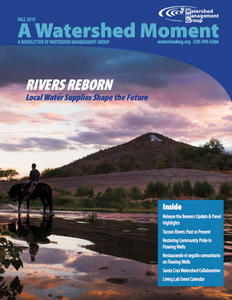Desert River Reborn - Local Water Supplies Shape the Future
The good news keeps coming for our rivers this year. In June, we celebrated the launch of the Santa Cruz Heritage Project, releasing recycled water into the river to support perennial ow through downtown Tucson. Now we learn another stretch of the Santa Cruz River is also owing regularly, thanks to restored groundwater levels.
The Tohono O’odham fought to gain water rights in the 1970s that allowed them to recharge Central Arizona Project (CAP) water on their lands and replenish groundwater that had been pumped in excess by the non-indigenous population. Rising groundwater levels have allowed the river to resurface, with a half-mile stretch owing now for more than one year!
I had the privilege of walking along this reborn river stretch on a eld trip with the San Xavier District as part of the Santa Cruz Watershed Collaborative in October. Hundreds of young cottonwoods had sprouted along the riverbed, promising a new era of life and hope.
It’s not just the Santa Cruz that is being reborn; I have good news to share from other parts of our watershed. WMG has been monitoring creek ow across the Tucson basin since 2017. Our community scientists have observed perennial stretches along both Sabino Creek and Tanque Verde Creek, including three years of continuous ow along one stretch of Lower Sabino Creek as well as rising groundwater levels nearby.
This winter, community scientists recorded 50 consecutive days of ow along the lower Tanque Verde Creek and upper Rillito River. While this year’s ow was fed by above-average rainfall and snow accumulation, historically this stretch of the river had groundwater supported ow for most or all of the year, up until the early1900s.
Ciénega Creek, a tributary of the Santa Cruz River, has two reaches with year-round ow. The creek’s ow is substantial enough that it is being considered as a location to reintroduce beavers in 2020 (see page 4).
Imported water from the CAP has allowed Tucson and surrounding communities to stop overpumping groundwater and to restore groundwater levels in locations across the Tucson basin. I’m pleased to see some of this recharge occur near our rivers, and I encourage our watershed planners to strategically recharge more CAP and recycled water in or alongside our rivers to support ow.
Looking forward, our community should embrace the potential of local water supplies to meet our water needs and restore our region’s heritage of owing creeks and rivers (see page 8). Our local water resources include rainwater, greywater, and stormwater, in addition to recycled water. Rainwater harvesting systems can typically supply all residential and commercial landscape water demands and can meet indoor residential water needs as well.
Water harvesting has quickly grown in popularity with Tucson households, and these solutions can be scaled up to reduce our municipal water demands in the face of climate change and dwindling CAP water supplies.
The City of Tucson took a big step forward in utilizing local water supplies with the recent approval of the Green Stormwater Infrastructure Fund. Tucson’s Mayor and Council directed Tucson Water to move forward with implementing the $3-$5 million annual fund dedicated to installing and maintaining public green infrastructure. The fund will substantially scale up our ability to collect and in ltrate stormwater in urban areas, supporting an urban forest as well as recharging more groundwater.
Our rivers are being reborn after a century of decline. This is a de ning moment for all the communities that live in our Santa Cruz watershed. We should rejoice alongside the Tohono O’Odham Nation and work beside them to restore ow to our rivers and quicken our pace towards a more resilient future. Each of us has a part to play, as we reduce our dependence on imported CAP water, cultivate our local water supply, and scale up conservation efforts.
Sincerely,
Lisa Shipek
Executive Director

